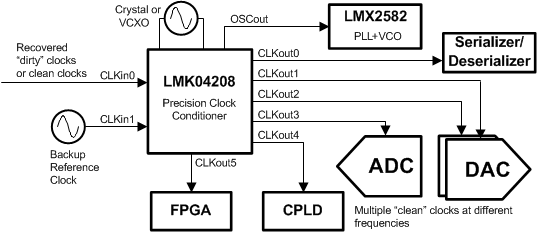JAJSCG7 September 2016 LMK04208
PRODUCTION DATA.
- 1 特長
- 2 アプリケーション
- 3 概要
- 4 改訂履歴
- 5 Pin Configuration and Functions
- 6 Specifications
- 7 Parameter Measurement Information
-
8 Detailed Description
- 8.1
Overview
- 8.1.1 System Architecture
- 8.1.2 PLL1 Redundant Reference Inputs (CLKin0/CLKin0* and CLKin1/CLKin1*)
- 8.1.3 PLL1 Tunable Crystal Support
- 8.1.4 VCXO/Crystal Buffered Output
- 8.1.5 Frequency Holdover
- 8.1.6 Integrated Loop Filter Poles
- 8.1.7 Internal VCO
- 8.1.8 External VCO Mode
- 8.1.9 Clock Distribution
- 8.1.10 0-Delay
- 8.1.11 Default Startup Clocks
- 8.1.12 Status Pins
- 8.1.13 Register Readback
- 8.2 Functional Block Diagram
- 8.3
Feature Description
- 8.3.1 Inputs / Outputs
- 8.3.2 Input Clock Switching
- 8.3.3 Holdover Mode
- 8.3.4 PLLs
- 8.3.5 Status Pins
- 8.3.6 VCO
- 8.3.7 Clock Distribution
- 8.3.8 0-Delay Mode
- 8.4 Device Functional Modes
- 8.5 Programming
- 8.6
Register Maps
- 8.6.1 Register Map and Readback Register Map
- 8.6.2 Default Device Register Settings After Power On Reset
- 8.6.3
Register Descriptions
- 8.6.3.1
Registers R0 to R5
- 8.6.3.1.1 CLKoutX_PD, Powerdown CLKoutX Output Path
- 8.6.3.1.2 CLKoutX_OSCin_Sel, Clock Group Source
- 8.6.3.1.3 CLKoutX_ADLY_SEL, Select Analog Delay
- 8.6.3.1.4 CLKoutX_DDLY, Clock Channel Digital Delay
- 8.6.3.1.5 Reset
- 8.6.3.1.6 POWERDOWN
- 8.6.3.1.7 CLKoutX_HS, Digital Delay Half Shift
- 8.6.3.1.8 CLKoutX_DIV, Clock Output Divide
- 8.6.3.2 Registers R6 to R8
- 8.6.3.3 Register R10
- 8.6.3.4 Register R11
- 8.6.3.5 Register R12
- 8.6.3.6 Register R13
- 8.6.3.7 Register 14
- 8.6.3.8 Register 15
- 8.6.3.9 Register 16
- 8.6.3.10 Register 23
- 8.6.3.11
Register 24
- 8.6.3.11.1 PLL2_C4_LF, PLL2 Integrated Loop Filter Component
- 8.6.3.11.2 PLL2_C3_LF, PLL2 Integrated Loop Filter Component
- 8.6.3.11.3 PLL2_R4_LF, PLL2 Integrated Loop Filter Component
- 8.6.3.11.4 PLL2_R3_LF, PLL2 Integrated Loop Filter Component
- 8.6.3.11.5 PLL1_N_DLY
- 8.6.3.11.6 PLL1_R_DLY
- 8.6.3.11.7 PLL1_WND_SIZE
- 8.6.3.12 Register 25
- 8.6.3.13 Register 26
- 8.6.3.14 Register 27
- 8.6.3.15 Register 28
- 8.6.3.16 Register 29
- 8.6.3.17 Register 30
- 8.6.3.18 Register 31
- 8.6.3.1
Registers R0 to R5
- 8.1
Overview
-
9 Application and Implementation
- 9.1
Application Information
- 9.1.1 Loop Filter
- 9.1.2 Driving CLKin and OSCin Inputs
- 9.1.3 Termination and Use of Clock Output (Drivers)
- 9.1.4 Frequency Planning with the LMK04208
- 9.1.5 PLL Programming
- 9.1.6 Digital Lock Detect Frequency Accuracy
- 9.1.7 Calculating Dynamic Digital Delay Values for Any Divide
- 9.1.8 Optional Crystal Oscillator Implementation (OSCin/OSCin*)
- 9.2 Typical Applications
- 9.3 System Examples
- 9.4 Do's and Don'ts
- 9.1
Application Information
- 10Power Supply Recommendations
- 11Layout
- 12デバイスおよびドキュメントのサポート
- 13メカニカル、パッケージ、および注文情報
1 特長
- 非常に低いRMSジッタ性能
- 111 fs、RMSジッタ(12kHz~20MHz)
- 123 fs、RMSジッタ(100Hz~20MHz)
- デュアル・ループ PLLatinum™PLLアーキテクチャ
- PLL1
- 低ノイズの水晶発振器回路を内蔵
- 入力クロック消失時のホールドオーバー・モード
- 自動または手動のトリガ/回復
- PLL2
- -227dBc/Hzの正規化PLLノイズフロア
- 最高速度155MHzの位相検出器
- OSCin周波数ダブラー
- 内蔵の低ノイズVCOまたは外部VCOモード
- 2つの冗長化されたLOS付き入力クロック
- 自動および手動スイッチオーバー・モード
- 50%デューティ・サイクルの出力分割、1~1045 (偶数または奇数)
- 6つのLVPECL、LVDS、LVCMOSプログラマブル出力
- デジタル遅延: 固定または動的に可変
- 25ps単位のアナログ遅延制御
- 7つの差動出力、シングルエンドで最大14
- 最大6つのVCXO/水晶振動子バッファ付き出力
- 最高クロック速度: 1536MHz
- 0遅延モード
- 電源オン時の3つのデフォルト・クロック出力
- マルチモード: デュアルPLL、シングルPLL、クロック分配
- 工業用温度範囲: -40℃~+85℃
- 3.15V~3.45Vで動作
- 64ピンWQFNパッケージ(9.0×9.0×0.8mm)
2 アプリケーション
- データ・コンバータのクロック供給
- ワイヤレス・インフラ
- ネットワーキング、SONET/SDH、DSLAM
- 医療、ビデオ、軍事、航空宇宙
- 試験/測定機器
3 概要
LMK04208は高性能のクロック・コンディショナーであり、高度な機能によってクロックの生成、分配、ジッタのクリーニングに優れた性能を発揮し、次世代システムの要件を満たします。デュアル・ループ PLLatinum™アーキテクチャにより、低ノイズのVCXOモジュールを使用して111 fsのRMSジッタ(12kHz~20MHz)、または低コストの外付け水晶振動子およびバラクタ・ダイオードを使用して200fs以下のRMSジッタ(12kHz~20MHz)を実現できます。
デュアル・ループ・アーキテクチャは、2つの高性能な位相調整されたループ(PLL)、低ノイズの水晶発振器回路、高性能な電圧制御発振器(VCO)で構成されます。最初のPLL (PLL1)は低ノイズのジッタ・クリーナ機能を提供し、2番目のPLL (PLL2)はクロック生成を行います。PLL1は、外付けのVCXOモジュール、または内蔵の水晶発振器と外付けの調整可能水晶振動子およびバラクタ・ダイオードとともに動作するよう構成できます。非常に狭いループ帯域幅と組み合わせた場合、PLL1はVCXOモジュールまたは調整可能水晶振動子の優れたクローズイン位相ノイズ(50kHzより低いオフセット)を使用して、入力クロックをクリーニングします。PLL1の出力は、PLL2へのクリーンな基準入力として使用され、内蔵のVCOをロックします。PLL2のループ帯域幅は、ファーアウト位相ノイズ(50kHzよりも高いオフセット)をクリーニングするよう最適化でき、この場合は内蔵のVCOが、PLL1で使用されているVCXOモジュールや調整可能水晶振動子よりも高性能になります。
製品情報(1)
| 型番 | VCO周波数 | クロック入力 |
|---|---|---|
| LMK04208 | 2750~3072MHz | 2 |
- 提供されているすべてのパッケージについては、巻末の注文情報を参照してください。
概略回路図

4 改訂履歴
| 日付 | 改訂内容 | 注 |
|---|---|---|
| 2016年9月 | * | 初版 |